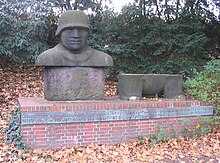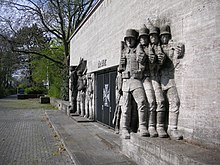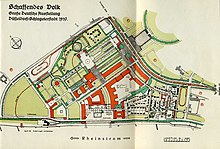War memorial (Düsseldorf-Golzheim)
The war memorial is located between Rotterdamer Straße and Reeser Platz in Düsseldorf - Golzheim . It is a replacement memorial for the soldiers of the 39th Fusilier Regiment who were killed or disappeared in the First World War . It was inaugurated in July 1939. The first - “Monument of the 39ers” for this purpose - was demolished early under the Nazi regime and for ideological reasons. On the other hand, this time it was expanded by him several times, in an ideological way, as it were.
prehistory
In the period after the First World War, a dispute over the term comradeship escalated . For example, it was argued about the form in which the fallen “frontline comrades” should be commemorated. How contradicting this development was despite all continuity is shown by something like “a patriotic industrial accident” in Düsseldorf in 1928. The traditional associations of the 39th Fusilier Regiment with the honorary name General Ludendorff announced a sculpture competition for a war memorial that year. The design by Jupp Rübsam - who himself was a "39er" - was accepted. Immediately after the war, Rübsam belonged to the avant-garde artist group Young Rhineland . But Rübsam did not see himself as a political artist when he took part in the competition. The title of his work was Inner Fortification : A helmeted and a soldier with a head bandage lie on their stomachs and hold hands. Although the work was not an anti-militarist monument, it nevertheless contradicted the common clichés of monument production during the Weimar period , because the German “heroes” are in the dirt with him, so to speak, and did not meet any Aryan requirements such as those formulated in the Nazi ideology. The judges apparently did not notice anything like this. The commemorative publication for the inauguration of the monument says: "The draft [...] expresses the idea of a war memorial strongly and purely and is also a flawless, purely plastic solution." An alleged "weightiness and monumental note" was praised. It can be assumed that the war veterans from the city also interpreted the monument in a folkish sense .
The patriots gathered at the inauguration - in the sense of the patriotism prevailing at the time - were surprised when the guest of honor of the day (the Sedan Day ), Erich Ludendorff , canceled his participation at short notice and took a verbal position against the monument. As the “general” of the World War and de facto military dictator from 1916 to 1918 , Ludendorff was worshiped in a quasi-religious manner - especially in large Nazi circles during the Weimar period and often elsewhere. He had also been instrumental in promoting the stab in the back legend , through which he had denied his own military defeat and failure and imagined a conspiracy by Jewish and socialist forces.
Rübsam dedicated his "39th Memorial" to the fallen of the 39th regiment. His main idea was to show camaraderie and mutual help. Even before the monument was erected in 1928, its formal language triggered a wide variety of reactions. It was criticized as one of the “usual” war memorials by the SPD and KPD , while extreme Nazi circles defamed it as not being “German” enough. The artists' association Das Junge Rheinland ( Rheinische Sezession ) and with it more than 400 artists defended Rübsam's work against such attacks and called on the city officials to stand by this monument and thus defend Düsseldorf's reputation as a city of art .
The demolition of the Rübsam factory in March 1933 shows - in connection with the date of Hitler's appointment as Reich Chancellor on January 30th, and the book burning in April 1933 - how urgent this political action was for the Nazi state.
history
After the first "39er Monument" , inaugurated in 1928, met with considerable criticism from some, among other things because of its expressionistic design, the Monument Committee of Regiment No. 39 launched a new competition in 1932 in which the joint design by Hamburg architects Rudolf Klophaus and Artur Tachill and the Hamburg sculptor Richard Kuöhl received 1st prize. After the first memorial was demolished in 1933, construction of the new memorial began in 1936. On August 3, 1938, the second foundation stone was laid for a “39er monument” on Reeser Platz.
After Dusseldorf in 1930 the capital of Gaus Dusseldorf had become, the thought had been given an exhibition parks in the city of new start-up. Gauleiter Friedrich Karl Florian developed ambitious ideas about a competition held in 1934 for a Schlageter forum until the mid-1930s . Dusseldorf was to become the center of the NSDAP Gau to the center of National Socialism in West Germany, following on from the Schlageter cult , the Schlageter national monument and Düsseldorf trade fair and art exhibition traditions . A completely new district had emerged in Düsseldorf. The model settlement, created as a settlement for the creative people , was named Schlageterstadt after Albert Leo Schlageter from 1937 and was located in the southern part of the exhibition grounds of the Reich Exhibition for the Creative People with living space for the high demands of Nazi leaders from politics, business and art.
In July 1939, less than two months before the outbreak of the Second World War, the monument, which was built especially at Ludendorff's request, was inaugurated in the Schlageterstadt district . The time was built by the National Socialists with the help of the Wehrmacht. It has provoked discussions since the end of the Second World War , not least because the Bundeswehr held commemorations on the square in front of it until 1988, thereby ignoring the unambiguous fascist aesthetic of the monument. In the post-war period , when the preservation of the memorial was questioned, it was ultimately left untouched - on the grounds that it was dedicated to the fallen soldiers and was 'artistically and architecturally' significant ” . In research, however, the memorial is predominantly regarded as a document of the Nazi culture of remembrance in Germany in the late 1930s. In addition, it originally referred to Düsseldorf's regained importance as a garrison town after 1933 .
In 1946 the city council wanted to have the "war-glorifying" work torn down. But this did not happen. It was initially still used for official memorial services for the war dead. In 1958 these were moved to the north cemetery . The facility was placed under permanent monument protection in 2002 . At the end of 2018, the memorial was discussed by citizens with the Düsseldorf Art Commission. The current state of the closed monument with the inhospitable place is to be changed. The visibility of the remains of the rebuilt mall at the Tonhalle should also be improved.
description
The war memorial is dedicated to the fallen soldiers of the Lower Rhine Fusilier Regiment No. 39 , a unit of the Royal Prussian Army and the German Army that was last stationed in Düsseldorf-Derendorf . In the middle of an unadorned shell limestone wall , which rises on the east side of a paved forecourt that extends to Rotterdamer Strasse, is a barred gate ("Gate of the Crypt ") to which an iron cross is attached. On both sides of the gate - shown in semi- relief and high relief - soldiers in war engines and shouldered rifles march out over stairs. The inscription: "- FOR THE GERMAN PEOPLE HONOR AND FREEDOM -" can be read above the gate. After the beginning of the Second World War, the names of conquered cities were carved. It is a work in the style of neoclassicism . In its realistic rendering of the German soldiers marching out of the crypt to fight again, it also corresponds to the National Socialist conception of art .
The geographical orientation of the monument - it points towards the Rhine and thus towards the west - expressed the idea of revenge on France . Since the memorial was commissioned as early as 1932, it was not, strictly speaking, a Nazi memorial, but the martial monument arose from the demons of the Nazi era, which was already on the horizon. With the inscription "For the German people honor and freedom" and with the names of cities conquered in World War II, which were also engraved later, it became an expression of the aggressive war policy of the National Socialists.
The historian , folklorist and head of the Dusseldorf Memorial and Memorial Bastian Fleermann , who deals with Rhenish history and the time of National Socialism , comes to the conclusion in an expert opinion that the monument is: “ ... according to the time of origin, context and use as to be classified as National Socialist ".
Web links
Individual evidence
- ↑ Hans Maes (ed.), Hatto Küffner, Edmund Spohr : Düsseldorf in stone and bronze . Triltsch Verlag, Düsseldorf, 2nd edition. 1984, ISBN 3-7998-0018-2 , pp. 76-77, 84.
- ↑ Rolf Purpar: art city Dusseldorf . 2nd Edition. Grupello Verlag, Düsseldorf 2009
- ^ A b Duisburg Institute for Linguistic and Social Research: War memorials as places of learning for peace education work
- ↑ https://www.duesseldorf.de/stadtarchiv/stadtgeschichte/chronik/duesseldorfer-stadtchronik-1938.html
- ↑ Stefanie Schäfers: From the Werkbund to the four-year plan. The exhibition "Schaffendes Volk", Düsseldorf 1937 . In: Düsseldorfer Geschichtsverein (Hrsg.): Sources and research on the history of the Lower Rhine , Volume 4 (= contributions from the Research Center for Architectural History and Monument Preservation of the Bergische Universität Wuppertal University , Volume XI), Droste Verlag, Düsseldorf 2001, ISBN 3-7700- 3045-1 . See website Existing development I
- ↑ http://schaffendesvolk1937.de/schlagetersiedlung/
- ↑ http://www.diss-duisburg.de/Internetbibliothek/Buecher/diss--kriegsdenkmaeler-friedenspaedagogik--2012.pdf
- ↑ https://www.duesseldorf.de/medienportal/pressedienst-einzelansicht/pld/werkstatt-tag-zum-39er-denkmal-am-reeser-platz.html
- ↑ Description on www.return2style.de
- ↑ https://rp-online.de/nrw/staedte/duesseldorf/streit-um-kunstwerk-neben-dem-39er-denkmal-in-golzheim_aid-19697887
- ↑ Discussion about the Nazi war memorial. Accessed April 28, 2019 (available until December 12, 2019).
- ^ Rheinische Post online: The new dispute over the old Nazi site in Düsseldorf
- ↑ http://www.diss-duisburg.de/Internetbibliothek/Buecher/diss--kriegsdenkmaeler-friedenspaedagogik--2012.pdf
- ↑ https://rp-online.de/nrw/staedte/duesseldorf/streit-um-kunstwerk-neben-dem-39er-denkmal-in-golzheim_aid-19697887
source
- http://www.fotos-von-duesseldorf.de/detail.php?picture_id=1192
- Entry in the monument list of the state capital Düsseldorf at the Institute for Monument Protection and Preservation
- Monuments on FKoester.de
- Image on www.bilderbuch-duesseldorf.de
- Picture on www.dazzledorf.net
- The Nazi memorial on Reeser Platz (PDF; 11.3 MB)
Coordinates: 51 ° 15 ′ 5.5 ″ N , 6 ° 45 ′ 28 ″ E



